 |
BRIONVEGA mod. Algol 11" - Italy - 1964 |
 |
|
|
Italiano
|
||||||
|
In 1964 the architects Marco Zanuso and Richard Sapper designed the Algol for Brionvega, an Italian company from Milan founded immediately after the II World War and active from 1945 to 1994. With that project was produced a television destined to revolutionize the previous aesthetic canons of TV and the same domestic environments that housed them. The small black and white television became one of the representative products of the Italian style of the Sixties, so much so that it soon became part of the permanent collection of various art museums, including the "Museum of Modern Art" in New York City together with the TS-502 radio receiver, another result of the ideas of the two architects. The shape of the Algol was characterized by the rounded and inclined screen, the plastic cabinet produced in three bright colors: sun orange, midnight black and moon grey, and the extractable metal handle. Together with the two architects, for Giuseppe Brion, entrepreneur and owner of Brionvega, a team of specialists created other Hi-Fi, radio and television equipments that is still highly sought after by collectors today, both for its design and the reliability of the materials. The appearance of many Brionvega products from the sixties defies the passage of time, radios, TVs and audio amplifiers are all designed by Zanuso and Sapper, and by going beyond their function they become furnishing accessories and symbols of modernity. The Algol was an 11-inch portable black and white television, it could receive TV signals in the VHF and UHF bands. It was equipped with an internal estectable whip antenna 3.28 ft long for the VHF signal, while for the UHF a circular antenna with a diameter of 7.677 in was used. At home it was still possible to connect an external antenna to the appropriate rear connector. Power could be supplied by the mains (125 - 160 - 220 Vac), or by a 12 Vdc car battery. The dimensions were:10.236x8.66x12.204 in (WxHxD), and the weight was 16.755 lb. © IK3HIA, 2007. |
|||||||
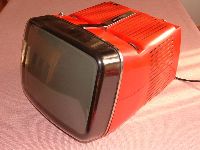 |
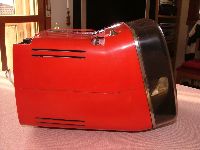 |
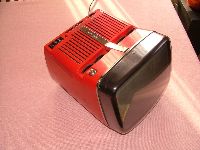 |
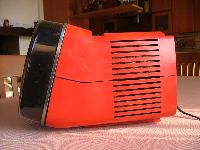 |
||||
|
Nel 1964 gli architetti Marco Zanuso e Richard Sapper progettarono l'Algol per la Brionvega una azienda italiana di Milano sorta nell'immediato dopoguerra e attiva dal 1945 al 1994. Con quel progetto fu prodotto un televisore destinato a rivoluzionare i precedenti canoni estetici delle TV e gli stessi ambienti domestici che le ospitavano. Il piccolo televisore in bianco e nero diventò uno dei prodotti rappresentativi dell’italian style degli anni Sessanta, tanto che entrò presto a far parte della collezione permanente di vari musei d'arte tra i quali il "Museum of Modern Art" in New York City assieme al ricevitore radio TS-502, sempre frutto delle idee dei due architetti. La forma dell' Algol era caratterizzata dallo schermo arrotondato e inclinato, dal mobiletto in plastica prodotto in tre brillanti colori: arancione sole, nero notte e grigio luna, e dalla maniglia estraibile in metallo. Assieme ai due architetti, per Giuseppe Brion, imprenditore e proprietario della Brionvega, un team di specialisti realizzò altre apparecchiature audio e radiotelevisive ancor oggi ricercatissime dai collezionisti, sia per il design che per l'affidabilita' dei materiali. L'aspetto di molti prodotti Brionvega degli anni sessanta sfida il trascorrere del tempo, radio, TV e amplificatori sono tutti firmati da Zanuso e Sapper, e superando la loro funzione diventano complementi d’arredo e simboli della modernità. L'Algol era un televisore portatile in bianco e nero da 11 pollici, poteva ricevere il segnale TV in banda VHF e UHF. Era dotato di una antenna interna a stilo estraibile da 1 metro di lunghezza per il segnale VHF, mentre per l'UHF veniva utilizzata un'antenna circolare del diametro di 19,5 cm. In casa era comunque possibile collegare delle antenne esterne agli appositi connettori con impedenza da 300 Ohm posteriori. L'alimentazione della Tv poteva essere fornita dalla rete elettrica (125 - 160 - 220 Vca), oppure da una batteria d'auto da 12 Vcc. Le dimensioni erano: 26x22x31 cm(LxAxP), e il peso era di 7,6 Kg. © IK3HIA, 2007. |
|||||||
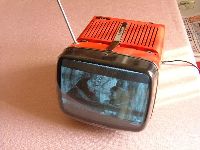 |
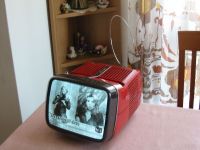 |
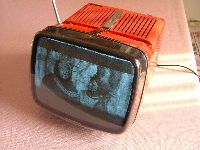 |
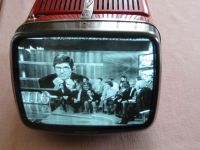 |
||||
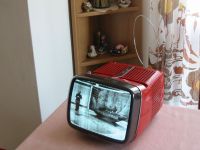 |
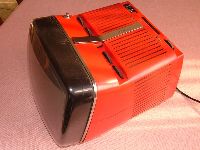 |
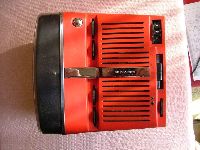 |
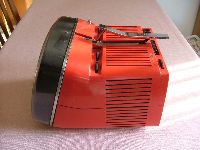 |
||||
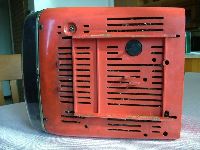 |
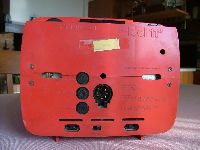 |
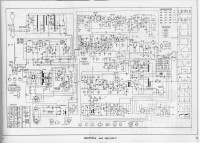 |
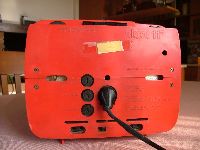 |
||||
| Click to return to the top of the page |
|
Click per tornare a inizio pagina | |||||
|
|
|||||||